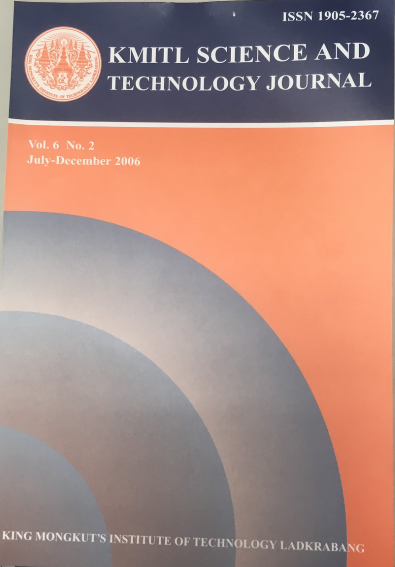REMOVAL OF HEAVY METALS FROM ELECTROPLATING WASTEWATER BY FERRITISATION
Main Article Content
Abstract
A laboratory scale reactor was designed for the purification of synthetic heavy metals containing wastewater and electroplating wastewater. The optimum conditions for ferritisation of heavy metal cations were studied with respect to the ratio of M2+ to Fe2+, the O2 flow rate, pH and temperature. The recommended ratio of Cu2+ to Fe2+, Ni2+ to Fe2+, and Zn2+ to Fe2+ were 1 to 2, 1 to 5 and 1 to 10, respectively, The optimum concentration of Fe2+ added to synthetic wastewater containing Cu-Ni, Cu-Zn, Ni-Zn and Cu-Ni-Zn were 800, 1,400, 1,600 and 1,400 mg 1-1, respectively. The Fe2+ concentration used to treat wastewater containing two and three metal cations was 100-200 mg 1-1higher than the Fe2+concentration used to treat wastewater containing a single metal cation. The optimum O2 flow rate, pH and temperature were 100 ml min-1, 10 and 50 C, respectively. Heavy metals in synthetic wastewater were remover > 99.5 %. 99.80% of nickel, 99.9% of zinc and 99.92% of iron were removed from electroplating wastewater.
Keywords: ferrite sludge, wastewater purification, hazardous materials, precipitation, decontamination, recycling
Corresponding author: E-mail: kcchompo@kmitl.ac.th
Article Details
Copyright Transfer Statement
The copyright of this article is transferred to Current Applied Science and Technology journal with effect if and when the article is accepted for publication. The copyright transfer covers the exclusive right to reproduce and distribute the article, including reprints, translations, photographic reproductions, electronic form (offline, online) or any other reproductions of similar nature.
The author warrants that this contribution is original and that he/she has full power to make this grant. The author signs for and accepts responsibility for releasing this material on behalf of any and all co-authors.
Here is the link for download: Copyright transfer form.pdf
References
[2] Wong, K.K., Lee, C.K., Low, K.S. and Haron, M.J. 2003 Removal of Cu and Pb from Electroplating Watewater using Tattaric Acid Modified Rice Husk, Process Biochemistry, 39, 437-445.
[3] Qdais, H.A. and Moussa, H. 2004 Removal of Heavy Metals from Wastewater by Membrane Processes: A Comparative Study, Desalination, 164, 105-110.
[4] Dabrowski, A., Hubicki, Z., Podkoscielny, P. and Robens, E. 2004 Selective Removal of the Heavy Metal Irons from Waters and Industrial Wastewaters by Ion-Exchange Method, Chemosphere, 56, 91-106.
[5] LaGrega, M.D., Buckingham, P.L. and Evans, J.J.C. 1994 Hazardous Waste Management, Singapore, McGraw-Hill, Inc.
[6] Patterson, J.W. 1975 Wastewater Treatment Technology. 2nd Edition. Stoncham, Butterworth Publisher.
[7] Tamaura, Y., Katsura, T., Rojarayanont, S., Yoshida, T. and Abe, H. 1991 Ferrite Process: Heavy Metal Ions Treatment System, Water Science and Technology, 23, 1893-1900.
[8] Tamaura, Y., Tu, P.Q., Rojarayanont, S. and Abe, H. 1991 Stabilization of Hazardous Materials into Ferrite, Water Science and Technology, 23, 399-404.
[9] Hencl, V., Mucha, P., Orlikova, A. and Leskova, D. 1995 Utilization of Ferrites for Water Treatment, Water Research, 29(1), 383-385.
[10] Wang, W., XU, Z. and Finch, J. 1996 Fundamental Study of an Ambient Temperature Ferrite Process in the Treatment of Acid Mine Drainage, Environmental Science and Technology, 30, 2604-2608.
[11] Barrado, E., Vega, M., Pardo, R., Grande, P. and Del Valle, J.L. 1996 Optimization of a Purification Method for Metal – Containing Wastewater by Use of a Taguchi Experimental Design, Water Research, 30(10), 2309-2314.
[12] Erdem, M. and Tumen, F. 2004 Chromium Removal from Aqueous Solution by the Ferrite Process, Journal of Hazardous Materials, B109, 71-77.
[13] Barrado, E., Prieto, F., Ribas, J. and Lopez, F.A. 1999 Magnetic Separation of Ferrite Sludge from a Wastewater Purification Process, Water Air and Soil Pollutution, 115, 385-394.
[14] Demirel, B., Yenigun, O. and Bekbolet, M. 1999 Removal of Cu, Ni and Zn from Wastewaters by the Ferrite Process, Environmental Technology, 20, 963-970.
[15] Barrado, E., Prieto, F., Garay, F.J., Medina, J. and Vega, M. 2002 Characterisation of Nickle-Bearing Ferrite Obtained as By-Products of Hydrochemical Wastewater Purification Process, Electrochimica Acta, 47, 1959-1965.
[16] Paulus, M. 1970 Proceeding of the International Conference on Ferrite, Tokyo, Japan, pp. 54-55.
[17] Barrado, E., Prieto, F., Vega, M. and Fernandez-Polanco, F. 1998 Optimization of the Operational Variables of a Medium-Scale Reactor for Metal – Containing Wastewater Purification by Ferrite Formation, Water Research, 32(10), 3055-3061.
[18] Takada, T. and Kiyama, M. 1970 Proceeding of the International Conference on Ferrites, Tokyo, Japan, pp. 69-70.
[19] Barrado, E., Montequi, J.I., Medina, J., Pardo, R. and Pricto, F. 1998 Electrochemical Study of Iron Ferrite Sludge Obtained Under the Conditions Proposed for the Purification of Wastewater at a Carbon Paste Electrode, Journal of Electroanalytical Chemistry, 441, 227-235.
[20] Mandaokar, S.S., Dharmadhikari, D.M. and Dara, S.S. 1994 Retrieval of Heavy Metal Ions from Solution via Ferritisation, Environmental Pollution, 83, 277-282.
[21] Miyadai, T., Seio, D. and Miyahara, S. 1970 Proceeding of the International Conference on Ferrites, Tokyo, Japan, pp. 54-55.


